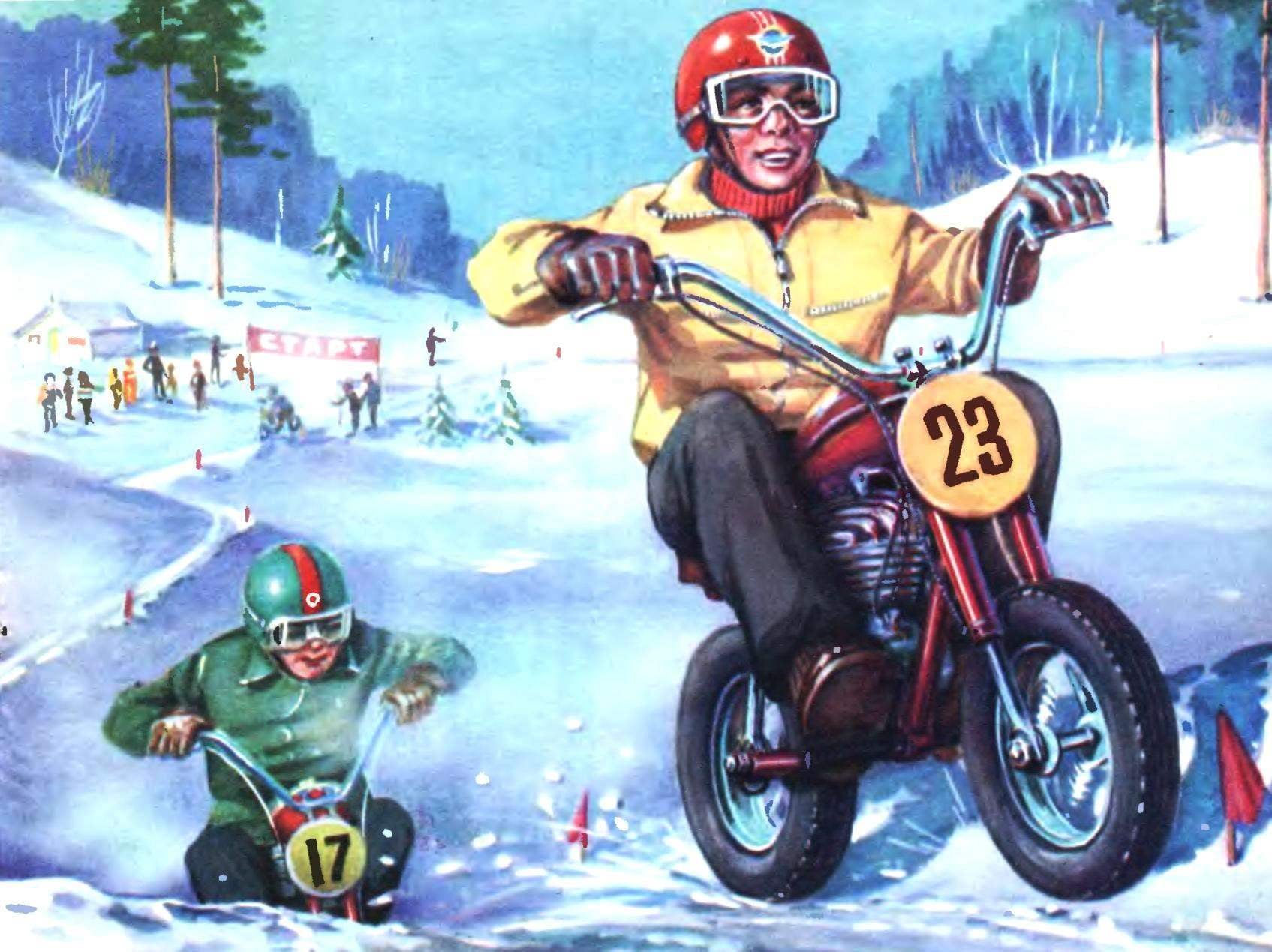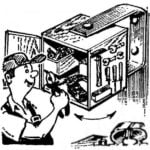
 Homemade mikromototsikly built using bicycle parts and children’s scooters, gaining among our youth is growing in popularity This is quite natural: a miniature car garage is not needed, it can be kept even in the apartment; its cost (both initial costs and maintenance costs) is very small; learn how to manage such a machine can be a few hours, and how many interesting trips will allow it to make, especially in the countryside!
Homemade mikromototsikly built using bicycle parts and children’s scooters, gaining among our youth is growing in popularity This is quite natural: a miniature car garage is not needed, it can be kept even in the apartment; its cost (both initial costs and maintenance costs) is very small; learn how to manage such a machine can be a few hours, and how many interesting trips will allow it to make, especially in the countryside!
To borrow from each other experience mikromototsiklov construction, designers, enthusiasts have a lot of improvements and innovations, making these some simple machines in general have gained valuable qualities such as increased permeability, comfort, speed.
Today we want to introduce readers to the work of student of 9th class of the 35th school in Minsk Arthur Tokmakova. He sent to the Editor description, drawings and photographs created by him mikromototsikla raised about the divergence, which he called “Meteor-cross.”
“Meteor cross” … A small, compact, lightweight and high-speed machine; on it is possible to go for mushrooms, fishing, engage in intelligence during the game “Summer Lightning”, compete in cross-country or on the slopes of figure driving.
Here he writes Arthur.
I am a longtime subscriber to your magazine. I look forward to each new issue of, since it is very interested in all-terrain vehicles, and “Model Construction” pays great attention to these machines. After reading about the competition “Avtogorodkam – their technique,” I have decided to take part in it. I decided to have a mikromototsikl terrain with velodvigatelem D-6. From an old bicycle “Eaglet” took the frame and redid her cut back the plug, cut the pipe. Instead carriage welded steel pipe of Ø 20 mm and 290 mm in length. It also serves as a footrest and brake pedal axle.
The rear wheel is suspended on a pendulum fork with shock absorbers on a moped “Riga” (or “Verkhovyna”). To fix this fork to the frame is welded steel tube with inner Ø 12 mm. It should be strictly horizontal at an angle relative to the frame axis.
From the back of the fork of the bike is cut off the vertical and eyelets for attaching the wheels; welded to the horizontal portion of the square plate of 4 mm thickness. Opilennye hand flattened tubes and rivet. To the rear of the pendulous fork welded eyelets for attaching the wheels of the scooter (tire size 12 * 1 / 2X2 * 1/4). In front of the pendulum fork drilled hole Ø 12,2 mm for M12 bolts, which plug is attached to the frame.

Micro bike “Meteor cross”:
1 – front wheel, 2 – brake drum 3 – a front brake cable, 4 front fork, 5 – Flybridge forks, 6 – the lever of the front brake, 7 – throttle, 8 – steering clamps, 9 – a coupling cable 10 to the clutch lever, 11 – fuel tank 12 – seat 13 – exhaust pipes, 14 – rear suspension, 15 – pendulum fork, 10 – step, 17 – engine D-5, 18 – the brake pedal.
The front fork for “Meteora” was taken out of the moped “Riga-7”; Her respectively shortened pipe, but the spring is left unchanged. The joint pipe must be carried out very gently, otherwise the spring will not operate normally. Portion of the plug to which the springs are mounted, is also shortened; opilenny rivet end, and it saws a groove under axial bolt Ø 8 mm.
Fuel tank – from the motorbike, a 2-liter, horizontally placed on the frame. Saddle – from moped “Verkhovyna-3.” Sports Silencer type of roofing iron welded and fixed to the frame obliquely upwardly as shown in the figure.
“The Eaglet” The rear wheel of the scooter (or bicycle) is converted to the rear hub of the bicycle with free lift Number of spokes doubled. When using small needles from motorcycles cubatures can leave them just as much. On the left sleeve is strictly coaxially driven sprocket is welded on the child’s bicycle. Mud guards – also on the children’s bike, but you can set and improvised.

No less interesting and mikromotoroplery mikromototsikly built by our readers:
1 – with the inertial flywheel motor; 2 – the battery, the motor and belt drive wheel; 3 – with an engine. internal “Irtysh” type of combustion and friction transmission; 4 – powered urban network cable and the motor of the sewing machine.
When making mikromototsikla “Meteor cross” in the road version should lengthen the rear panel to the mud from under the wheels do not splash the driver’s back when driving on wet roads, install a headlight and taillights (preferably small-sized example of the moped) and use electrical equipment on a moped “Riga-7.”
Road performance of both of my machines embodiment are approximately the same: maximum speed – in the range of 25-30 km, cross-country (considering the small diameter of the wheels) is good, go to the “Meteor” very pleased by the fact that both wheels have a spring suspension. With reasonable selection and boosting of motor driven sprocket teeth with reduced speed, it can certainly be improved.
Our comment
Construction mikromototsiklov, mikromotorollerov, mikrosamokatov received new impetus: the whole mikrotransport found a certain sphere of practical application – in children’s camps and training venues. Suddenly it found that it’s not just funny propelled crafts, but useful and quite childish educational and transport vehicles, by which is completely safe, you can instill in the children a driver’s skills and to explore with them, in fact the traffic rules. In this regard, in recent years, a host of interesting designs. Returning to the subject mikromototsiklostroeniya, we hope that the amateur interested in the development and production and, perhaps, even put the production of the best of them on the conveyor.
As often happened in the history of art lovers digging in archives etc. breathed style new life into the seemingly long-forgotten ideas successfully applied elements or parts of production vehicles. So. besides the traditional circuits of internal combustion engines of mopeds and motorbikes, were very good decisions with the use of motors of power saws, water pumps and outboard motors with witty and at the same time simple enough torque transmission from the engine to the drive wheel. Come on in the course of V-belt transmission and friction, of which the most interesting, perhaps, is to set to “indoor” motor scooter from the sewing machine! The pioneer of the use of motorized carriages outboard became a veteran of technical creativity, head of the Children’s Club A. Abramov. His self-propelled bench described in our magazine No. 7 for 1976. Interesting and promising attempt to use as a motor scooter to the generator from the car “Moskvich-401” battery-powered 6 Q. Finally, a very timely application for this engine flywheel according to the scheme proposed by Professor NV Gulia (see. Number 8 of 1578).
The most interesting of our readers constructed micromachines are shown in tab. Descriptions of some of them will be published in the next issues.



